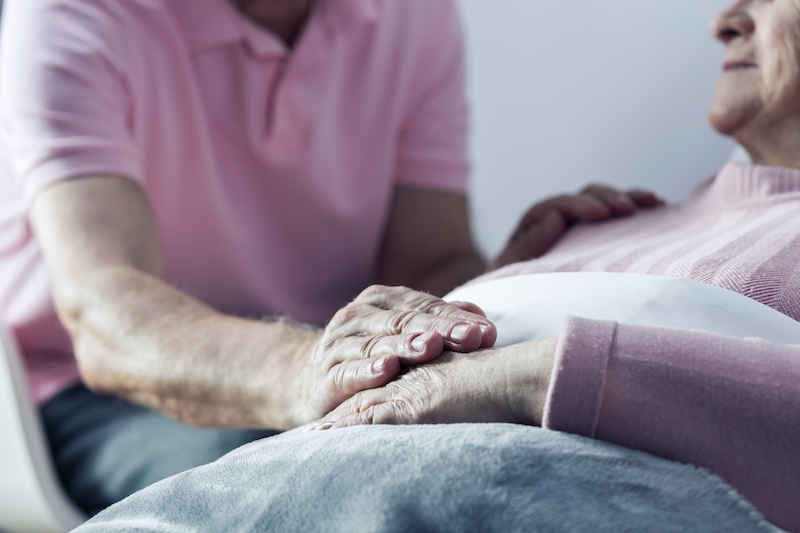According to Chaplain Dorothy Gannon with Bethesda Hospice Care, your presence is the most important thing you can share with a hospice patient. “What matters most has nothing to do with what you say,” Dorothy says. “It is the fact that you are willing to be there with the person.
Listen When Communicating With a Hospice Patient
Rather than concerning yourself with saying all the right things, Dorothy suggests approaching the conversation with a couple of questions and a mindset to listen. The questions could be as basic as how the person is feeling or how the family is doing. “You let them respond, and then follow their lead,” she says.
Listening is a skill that requires thought and attentiveness. You indicate your interest in what is being said by nodding, affirming, and something Dorothy calls “recapping;” re-expressing or summarizing what you have just heard back to the person who has been talking. “It’s a real gift and encouragement to the person who is sharing if you can identify the emotion behind what has been said. If you can, say, for example, ‘I can tell that makes you sad, it would make me sad.’”
According to Dorothy, there should be two levels of conversation occurring between a hospice patient and a visitor. Both levels should be determined by what the patient has indicated they want to talk about. On the first level, if the relationship has always been based on telling jokes, or talking about sports, then continue to do that. “But if the patient says, ‘I’ve probably been to my last baseball game,’ the listener shouldn’t try to gloss over and move past that statement. There should be an encouragement to expand on that and the feelings behind it. It says to the person ‘I’m willing to listen to your emotions if you are willing to talk about them,’” Dorothy says.
Also, be aware that people stay true to who they are even as they are dying. “If someone was always a private person who kept themselves in check, that’s who they will probably continue to be. People become more distilled versions of themselves as the unimportant things fall away,” Dorothy says.
Don’t Limit Your Interactions
“A lot of people believe they are protecting their loved one by not talking about dying,” Dorothy says. “Hospice patients are often aware of what is happening to them, so trying to protect the person backfires. The result is a feeling of isolation and loneliness because there is no one to talk to about what is happening to them.”
In addition, remember that hospice patients are still people with opinions, abilities, experiences, knowledge, and skills. If they are able, involve them in decisions, and ask for their opinions and advice. “Mom can no longer cook Thanksgiving dinner, but she has that great pumpkin pie recipe in her head,” Dorothy says. “When you ask her for the recipe, it says to her that she still has value.”
Written messages can be a blessing for hospice patients as well and make it easier for some people to express themselves rather than in face-to-face conversation. “Many people can allow themselves to be more open in a written form,” Dorothy says. She notes that expressing gratitude for having known the hospice patient, recalling a treasured memory, or revealing what the patient has taught them about life are cherished.
One fear of people visiting hospice patients is that they will lose control of their emotions and begin to weep. Be prepared that even the most innocent-sounding statements can elicit tears from a hospice patient. This is not necessarily a bad thing.
“What many people don’t realize is that those tears and pain are already inside the person,” Dorothy says. “All you have done is give them the opportunity to express them.”
And weeping, if it is shared with the patient, creates an important level of trust. “Being able to cry with a person is an incredible gift,” Dorothy says. “It says to the person that you both are being honest about how you feel.”
Thoughts from Hospice Patients
Dorothy has noticed that hospice patients spend a lot of time in what she calls “life review,” a story-telling process of what they have experienced and a search for meaning in those experiences. “They try to determine what their life has said about them—figuring it all out and making peace with it,” she says.
As a Chaplain, Dorothy sometimes hears stories about regrets or worries that a loved one or even God cannot forgive them for past mistakes. Another thought that hospice patients sometimes struggle with is how to define themselves as people while they are dying. “They want to know what their life is about when it is no longer defined by what they do.”
The hospice patients Dorothy sees are generally elderly, and most have come to terms with what happens after they die. Their concern is about the process. Will they be alone? Will it be painful? “We keep them comfortable and provide as much support as possible,” she says.
Another concern is for the loved ones they will leave behind. “They want to be assured that their loved ones are going to be fine,” Dorothy says. “I have witnessed hospice patients clinging to life, seeking the reassurance that people they care about will be okay. That’s one of the reasons it is so important to see a hospice patient and provide them with the comfort of knowing they can go when they are ready.”
When a patient is dealing with a life-limiting illness, it can be a trying time for the loved ones. Bethesda’s dedicated care professionals can make the transition more comfortable for the whole family. To learn more about Bethesda’s Hospice Care services and our grief support groups, please contact us.
| Bethesda has a 133-year tradition of providing excellent senior living options, including independent living, assisted living, memory care, and skilled nursing. If you are considering memory care, we welcome you to tour one of our exceptional communities, including Bethesda Dilworth, Bethesda Meadow, Bethesda Southgate, and Bethesda Hawthorne Place. Discover the level of care that only a non-profit staffed by highly-trained nurses, therapists, and aids can offer. |
Want to find out more?
If you’d like to stay up to date with Bethesda Health Group, sign up here to receive our blog and newsletters!
"*" indicates required fields
Related Articles
Want to find out more?
If you’d like to stay up to date with Bethesda Health Group, sign up here to receive our blog and newsletters!
"*" indicates required fields



